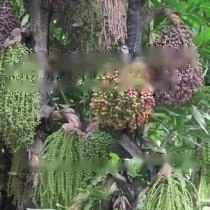
Chinese name: short spikefishtail sunflower
Latin name: Carvota mitis Lour
Aliases: wine coconut, Congsheng Fishtail Amur
Species: Brassica chinensis
Distribution area: Vietnam, Myanmar, India, Malaysia, Philippines, Indonesia also distributed
1. Morphology of Brachypodium
Brachypodium is a cluster of small trees, five to eight meters in height and eight to fifteen centimeters in diameter, with green stem veins and white fluff on the surface. . The leaves are three or four meters long, and the lower pinna is smaller than the upper pinna. Pinna is wedge-shaped or oblique wedge-shaped, the outer edge is straight, more than 1/2 of the inner edge is curved into an irregular tooth deficiency, and extends into a tail tip or short tip, light green, the young leaves are thinner, and the old leaves are nearly leathery; Petiole covered with brown-black felt-like tomentum; leaf sheath margin with reticulate brown-black fibers. Spathes and inflorescences are bran-like scales, inflorescences short, 25-40 cm long, with densely spike-like branched inflorescences; male sepals broadly obovate, about 2.5 mm long, 4 mm wide, apex entire, with eyelashes, The petals are narrow and oblong, about 11 mm long and 2.5 mm wide, pale green.
2. The value of Brassica chinensis
Brassica chinensis plants grow in clusters, the tree shape is plump and rich in layers, and Brassica chinensis leaves are green and flower color Bright yellow, the fruit is like a string of beads. It is suitable for cultivation in parks, ornamental in courtyards, and can also be potted for interior decoration. Alepi: Marrow cures indigestion in children, abdominal pain and diarrhea, and white dysentery. Dian Medicine Records. Alepi: Marrow cures indigestion in children, abdominal pain and diarrhea, and white dysentery. Records of Yunnan Province. Alaipi: The crude starch of stem pith is mainly used to treat diarrhea, dyspepsia, abdominal pain, and white dysentery in children. Infused starch from pith: used for dysentery, diarrhea, and diarrhea in children.
3. Planting of Brassica chinensis
Brassica chinensis can be propagated by seeding and division. Generally in spring, the seeds are sown in shallow pots with permeable and ventilated sandy loam as the matrix, covered with about 5 cm of matrix, and placed in an environment with a shading degree of about 30% and a temperature of about 25 °C, keeping the soil moist and covered with a high temperature. Air humidity. Brassica chinensis has strong growth potential, developed root system, and is not strict with soil conditions. Potted plants can be mixed with equal amounts of garden soil and leaf humus as the substrate. Generally, repot every 1-2 years. When repotting, remove part of the old soil, cut off part of the old roots, replant with new soil, and add a small amount of decomposed organic fertilizer. March-October is the main growth period. Generally, liquid fertilizer or compound fertilizer is applied 1-2 times a month to promote the vigorous growth of the plant; keep the pot soil moist in civil times, and spray water on the surface in dry climate conditions to ensure The leaves are green and shiny.
Guess you like it
Palm Kuwait | Sugar Palm | Dong Palm | Black Palm | Golden Palm | South Coconut | | Madagascar Coconut|
Nanga Brown | European Brown | Sunflower|
Huaxi Weigan Thorn Palm|Single-spiked Fishtail Kwai| Western Yunnan SnakePicture|East Australian Palm| Red Betel Nut | Red Veined Sunflower |
Red Palm | Hook Palm | Qiong Bamboo | Oil Bamboo | Hairy Bamboo Shoot |
![[Dog Training 5] The training method of pet dog dining etiquette](/static/img/12192/12192_1.jpg)




